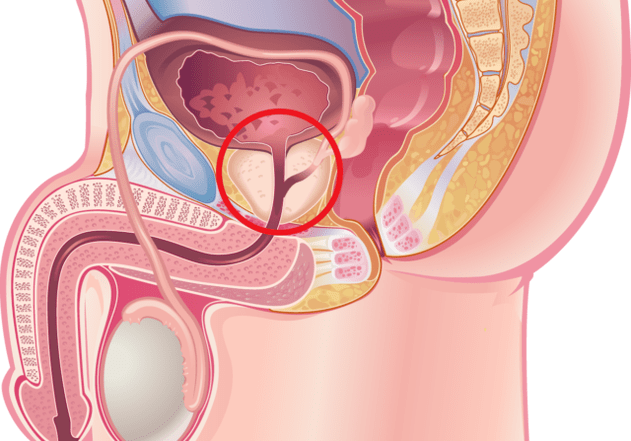Prostatitis or Prostatitis ICD highlights several numbers in its list. It all depends on the form and origin of the pathology.
What is an ICD
There is a regulatory document in the medical community that is regularly reviewed by the World Health Organization. It contains a list of all diseases and pathologies that occur in humans. It is called the International Classification of Diseases (ICD). Its main purpose is to help study the patient's condition and to create optimal conditions for this by systematically recording the available data. The information is collected from all over the world and coded under certain names. It can be supplemented and recalled at any time for further study.
Important! The ICD table contains classes and groups marked with codes. A keyword can contain several forms and manifestations of the same disease. The entry is arranged in alphabetical order for convenience.

Prostate diseases according to ICD-10
The list of diseases includes:
- acute prostatitis ICD 10 41, 0;
- chronic prostatitis ICD 10 41, 1;
- prostate abscess - 41, 2;
- prostatitis - 41, 3;
- other inflammatory conditions of the prostate - 41, 8;
- unspecified inflammatory disease of the gland - 41. 9.
An ordinary person does not need to know ICD coding. Only a doctor can decrypt and encrypt the diagnosis.
Inflammation of the prostate according to ICD-10
Code for prostatitis according to ICD 10-41. If benign hyperplasia develops in the organ, the disease is indicated by a different number. Prostate adenoma according to ICD 10 is registered in adults at 40-51. These sections contain various fibromas and fibroids.
It is one of the most common urological diseases, affecting men of all ages. In general, the inflammatory process in the glandular tissues is most often observed in chronic form, without the acute signs seen at the beginning.
Experts classify the disease according to the nature of the course:
- acute, occurs in 50% of patients aged 30 to 35 years. It is mostly associated with bacterial infections;
- chronic. It does not manifest for a long time and can develop in the background of an infectious process.
Due to the occurrence, it occurs:
- a bacterium that occurs in the body;
- non-bacterial, in which pathological lesions occur predominantly in chronic form;
- viral in which the entire genital area suffers.
According to the nature of structural changes, the following can be distinguished:
- fiber form. Glandular tissue growth occurs fairly rapidly and requires radical treatment. Clinically similar to prostate adenoma ICD, of which 40, 0;
- calculating. This occurs when limescale is formed in the tissues of the glandular tissue. It is considered a precursor to cancer;
- stagnant form. It occurs from sex with physical inactivity and long stay.
Causes and symptoms
Glandular pathology, both chronic and acute, is directly related to poor lifestyle, smoking and alcohol dependence, and poor physical activity.
The main reasons why the disease develops even in young men are:
- infections that can be transmitted during sexual contact: gonococci, Escherichia coli, chlamydia, etc. Frequent exchanges of sexual partners increase the risk of developing the disease;
- congestion of pelvic organs with damage to blood circulation;
- sedentary, sedentary lifestyle, physical inactivity;
- prolonged abstinence from sex, abuse of drugs that prolong sexual intercourse, intentional delay of ejaculation during intimacy in order to prolong it;
- decreased immunity;
- psycho-emotional stress, severe stress;
- physical overtime;
- hypothermia;
- failure in the endocrine system;
- unbalanced diet;
- dependencies.
Signs of developing acute and chronic inflammation of the prostate are similar. The doctor will help you recognize the form of the disease after the examination and diagnosis.
Peculiarities
The acute form is accompanied by severe clinical symptoms and all tissues of the glandular organ are involved in the pathological process. Therefore, the disease is painful, severe: with an increase in body temperature, with signs of general intoxication.
The patient complains:
- heaviness and pain in the groin, pelvic region, lower back;
- feeling of rectal tightness;
- increased urination, including at night;
- pain in the urethra after ejaculation and bladder emptying.
In the chronic form of lower abdominal disease, some men experience varying degrees of pain, erection, and potential problems. In 95% of cases, the disease is virtually asymptomatic.

The ICD encodes acute and chronic prostatitis
ICD 41. 1 of chronic prostatitis can be exacerbated by any adverse factor. Acute inflammation of ICD 41. 0 leads to edema of glandular tissues filled with acute urinary retention.
Such diseases, if not treated properly, lead to serious complications:
- bladder obstruction;
- the development of male infertility;
- narrowing and scarring of the urethra;
- recurrent cystitis;
- pyelonephritis and other diseases affecting the kidneys;
- discoloration of glandular tissues requiring immediate medical intervention;
- sepsis, which most commonly develops in people with weakened immunity.
Diagnosis of pathology
In some cases, a single rectal examination and knowledge of the patient's complaints is sufficient to make a diagnosis. However, inflammation is primarily diagnosed by laboratory and instrumental methods.
The patient is referred to:
- blood and urine tests to detect infections and inflammation;
- analysis of prostate secretions;
- ultrasound of the prostate, kidneys, bladder;
- urethrocytoscopia;
- MRI of pelvic organs;
- PSA blood tests;
- biopsy;
- X-ray.
One of the most effective diagnostic methods is rectal digital examination of the prostate. Although in acute form, the organ is very sensitive and the procedure can cause severe pain to the patient.
Treatment tactics
Chronic prostatitis, which has an ICD code in the International Registry of Diseases, requires complex treatment. The patient is advised to correct their diet, make lifestyle changes, give up harmful addictions, and start eating properly.
Also appointed:
- Medicine. It helps relieve pain, relieves inflammation, and activates the regeneration of damaged cells in the gland. Suppositories are mainly used as well as antibiotics.
- Prostate massage. This is the most effective way to get rid of stagnant processes in the gland. This is done independently or with the help of a professional. The procedure is considered inconvenient but needs to be repeated.
- Balneotherapy. With the help of mineral waters, men in sanatoriums manage to cope with the chronic form. It is also useful to drink and bathe in medicinal water.
- Physiotherapy. Thermal physiotherapy gives excellent results. It helps to quickly assimilate medications, relieve general symptoms, and increase blood circulation to a problem organ.
- Diet is an important step in therapy. The convalescent diet should include vitamins, fiber, amino acids, and minerals. You should refrain from fast food (pickles, marinades, smoked meats, fried, fatty foods). The list of desirable products includes sour milk drinks, lean meats and fish, nuts, dried fruits, pumpkin seeds.
Surgery is rarely used for chronic inflammation when other treatments have no positive effect or purulent processes have begun.
It requires the use of acute medications, microclusters, rectal suppositories, painkillers, painkillers. The patient shows bed rest and denies intimacy. As the acute period passes, prostate massage and physiotherapy are prescribed. It is very important that these types of diseases select the drugs they need. This is only possible after a correct diagnosis. What funds are prescribed and in what doses, the specialist says.
Prophylaxis
In order to prevent the development and worsening of prostatitis, ICD code 10 for adults is included in number 41, you must follow the following rules:
- lead an active and healthy lifestyle. If it is not possible to visit the gym, it is necessary to do morning exercises, warm up during the working day and walk. A kind of gym serves as a stairway through which one crawls into one’s apartment daily;
- avoid body hypothermia: do not sit on a cold surface, dress for the weather, etc. ;
- in case of constipation, include food that relaxes the intestines in the diet, take mild laxatives. If the disorder persists, it is advisable to consult a specialist;
- regulates sex life. Prolonged sexual abstinence is the first step toward the development of glandular diseases. If you do not have a permanent sexual partner, you can temporarily replace it with masturbation, but you should not engage in this activity;
- avoid contraception that prevents sexual intercourse. Sexually transmitted diseases cannot be noticed at first, but they severely damage glandular tissue, causing an infectious form of prostatitis;
- if you have the slightest suspicion of a sexually transmitted infection, you should consult a venereologist or urologist. It is enough to go through an examination to find out what is causing the unpleasant symptoms;
- you should visit a urologist at least once a year to rule out the possibility of developing the disease.
Opinions
- "The international classification is of no importance in the treatment of prostatitis of any etiology, as the ICD 10 code allows the precise definition of the type of disease, the formulation of the diagnosis and the implementation of effective therapeutic measures. "
- "My father had a prostate adenoma. The ICD code was deciphered by the doctor when it was determined by the diagnosis. The stage was rather neglected, the gland almost tripled. One surgery was scheduled and it was successful. Healing is delayed due to age (over 60 years) and other chronic illnesses. He's not complaining about the urogenital system now. "
- "Chr. Prostatitis ICD 41. 1 is on my card. I have suffered from this disease for a long time, but it very rarely gets worse as I do everything I can to avoid the onset of acute symptoms. The doctor said that chronic diseases do not go away, you maythey don't show up for a very long time if you monitor your health properly. That's why I use sports - I run, exercise every morning, I don't drink alcohol, I don't smoke. "
























